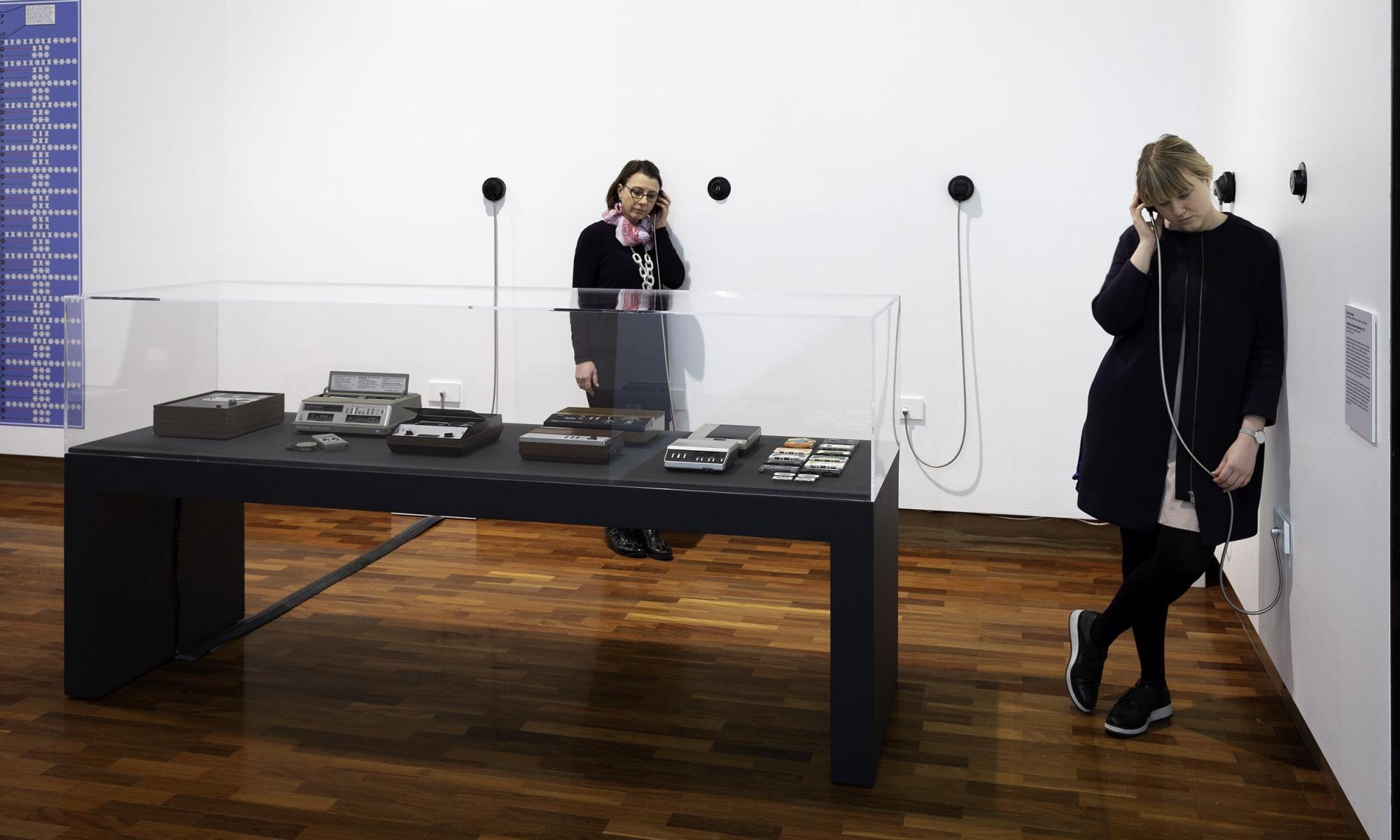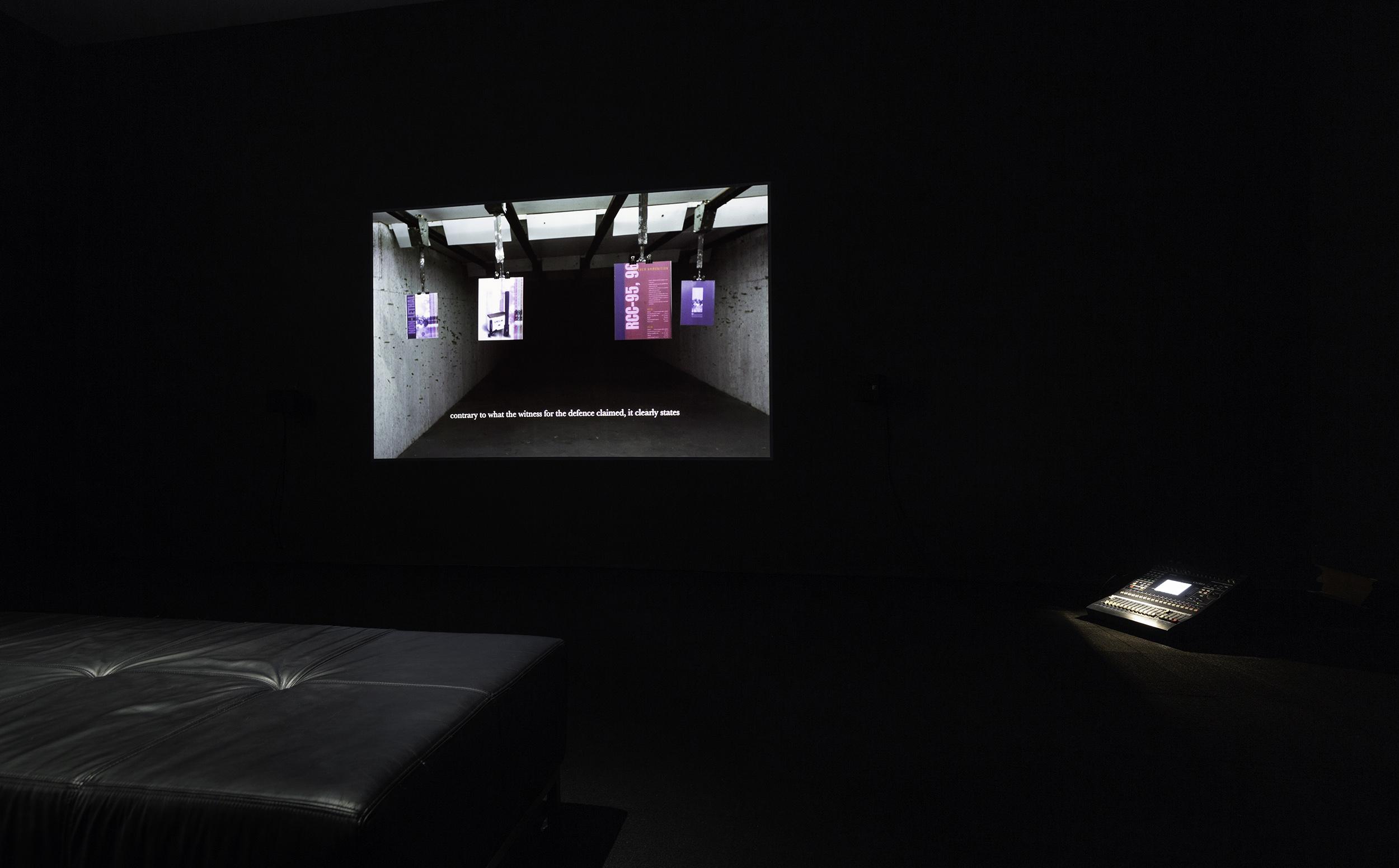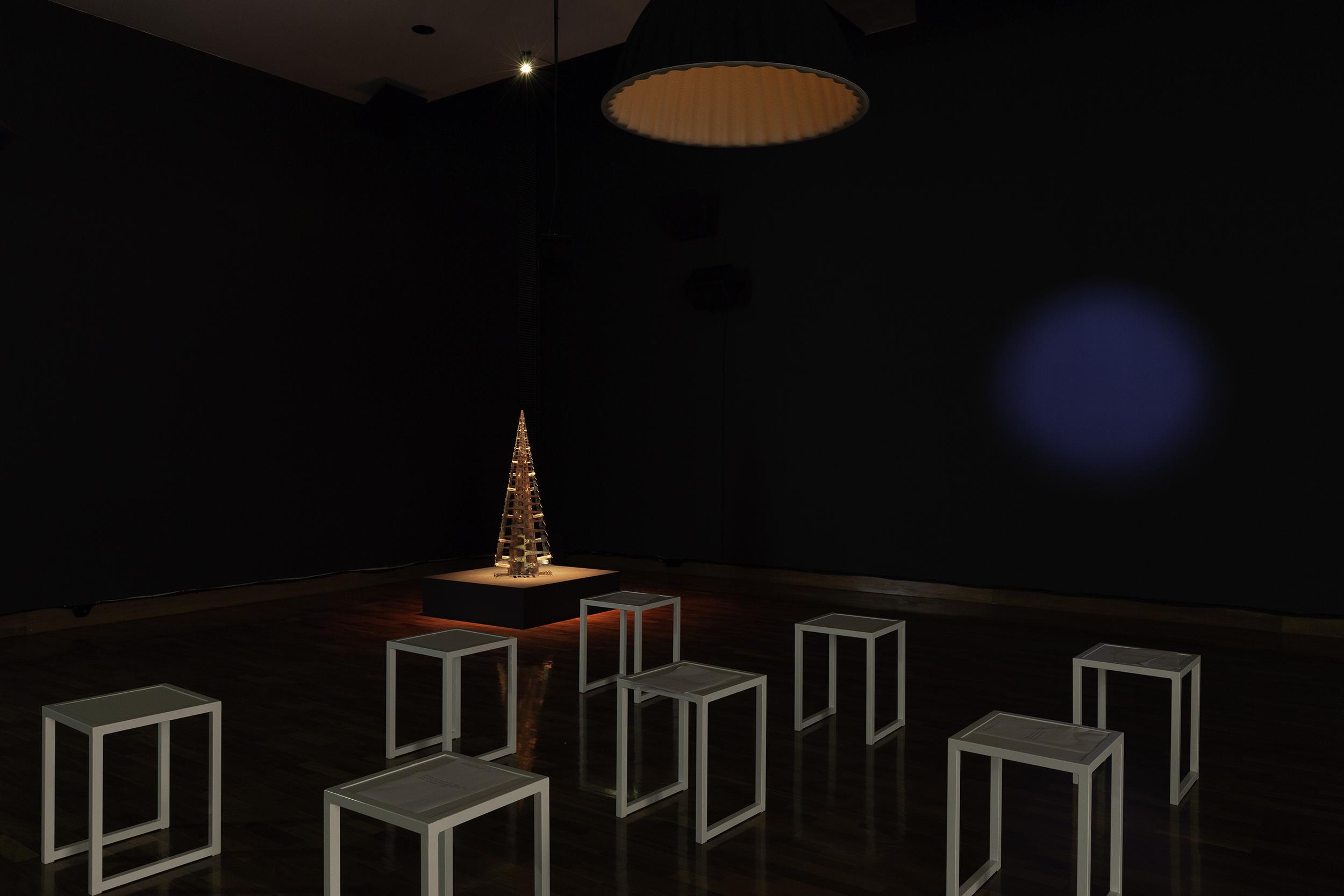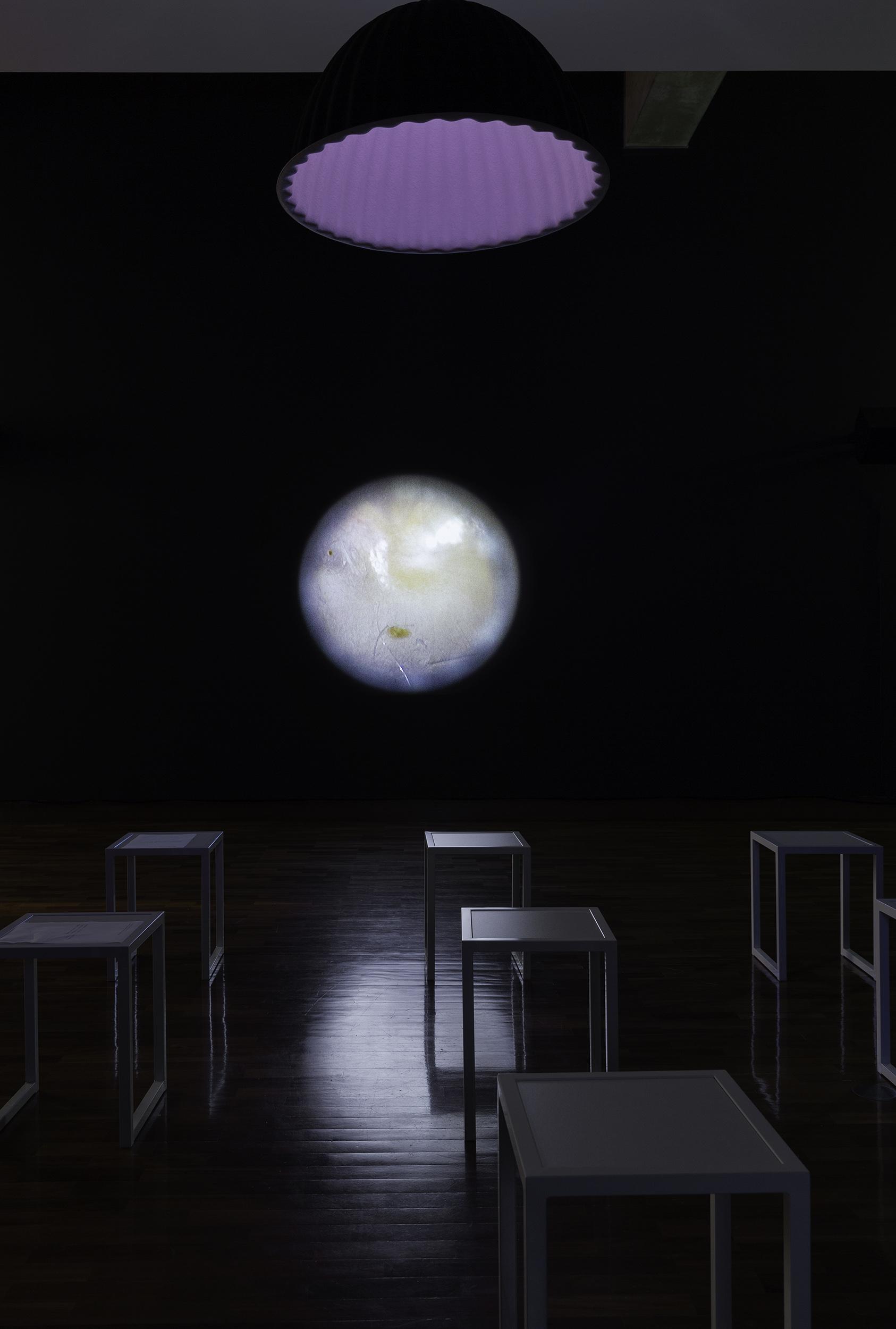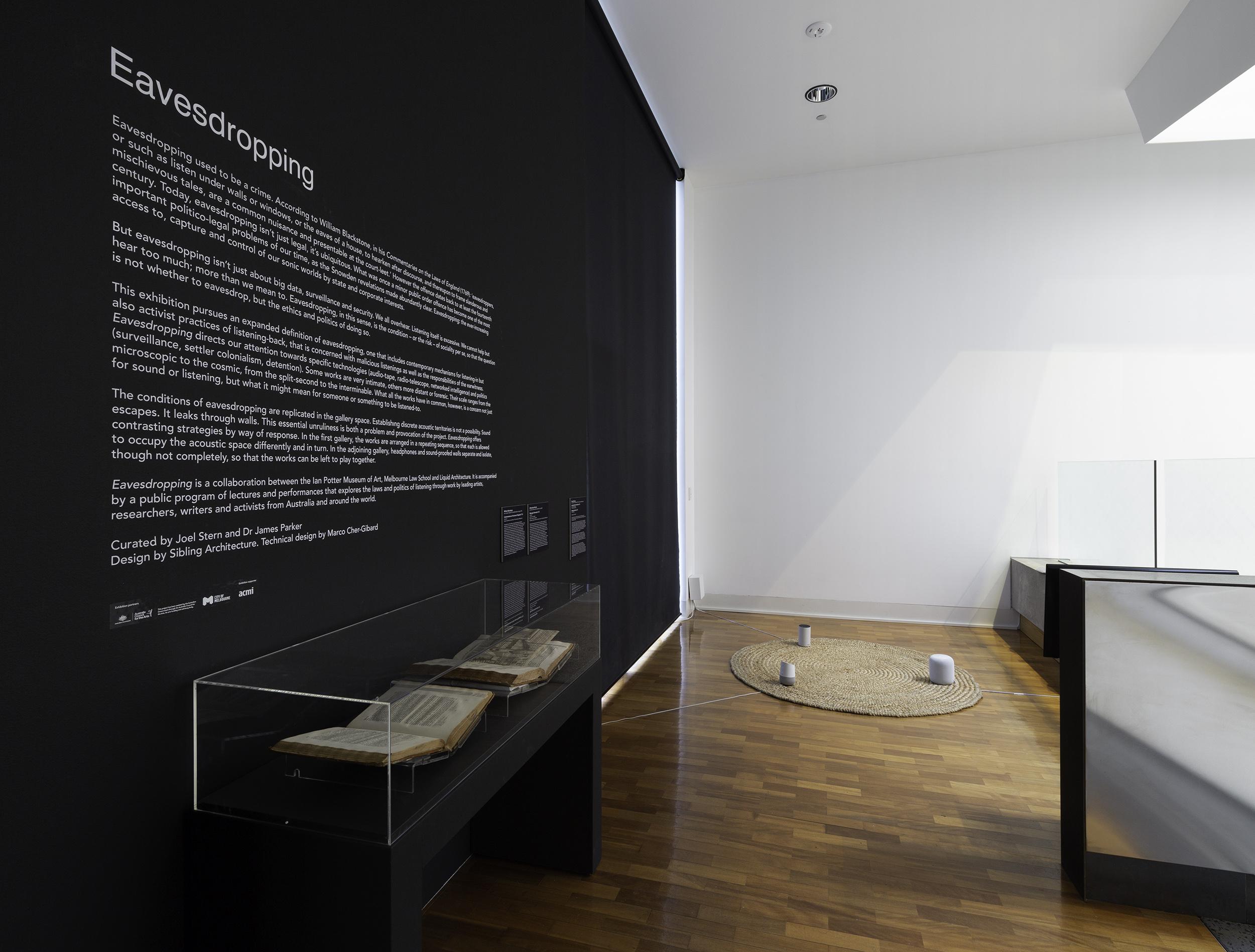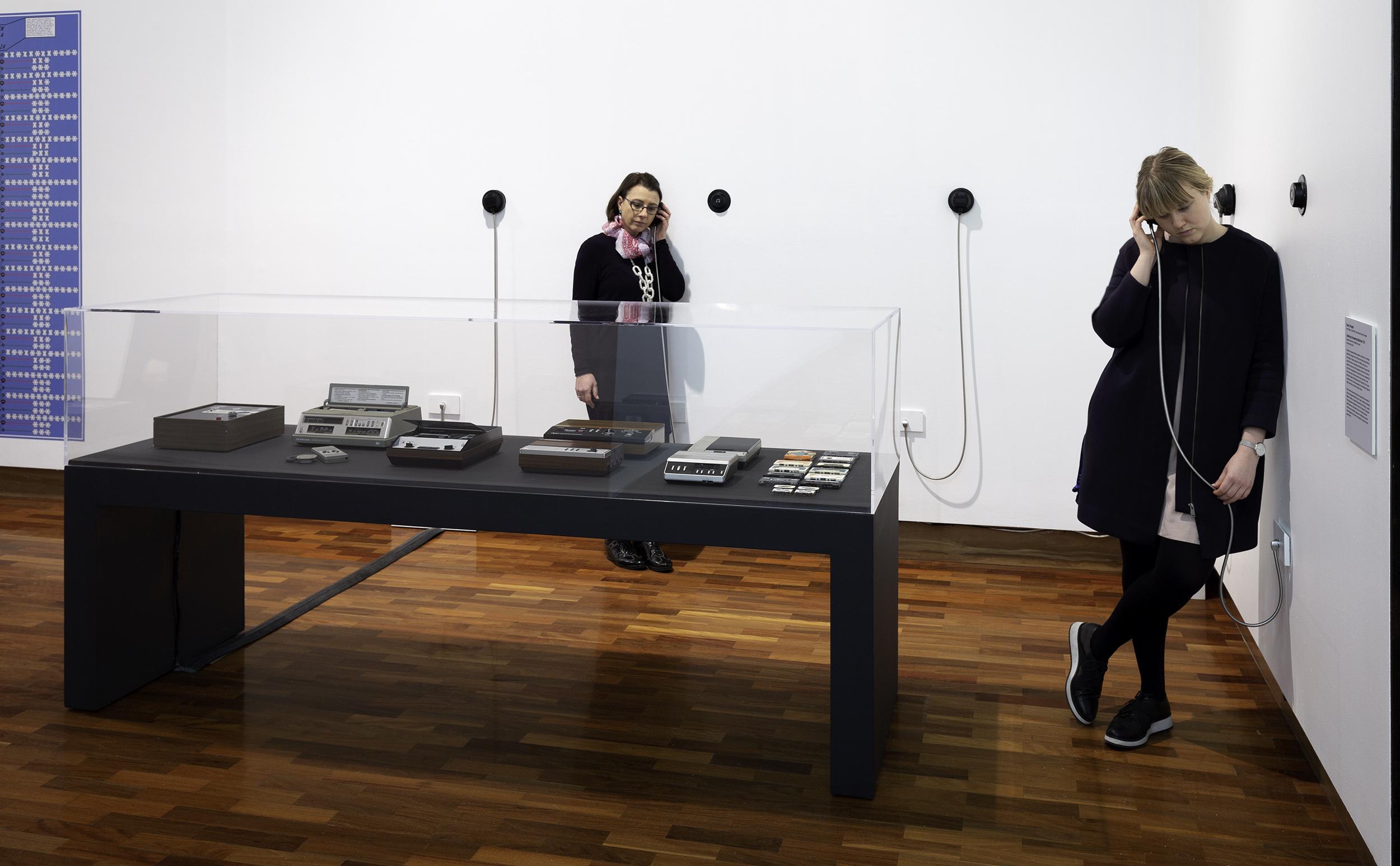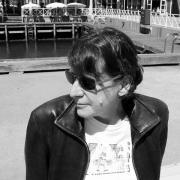Eavesdropping, Curated by Joel Stern and James Parker
What was once a minor public order offence has become one of the most important politico-legal problems of our time, as the Snowden revelations made abundantly clear. Eavesdropping: the ever-increasing access to, capture and control of our sonic worlds by state and corporate interests. But eavesdropping isn’t just about big data, surveillance and security. We all overhear. Listening itself is excessive. (Curatorial statement, Joel Stern and James Parker).
An outstanding activist-driven exhibition, Eavesdropping, offers a provocative, timely, and compelling experience for audiences. Thoughtfully curated by Joel Stern (Liquid Architecture) and James Parker (Melbourne Law School), the exhibition approaches eavesdropping at the unexpected intersection of legal and sonic concerns. The curators’ proposition is that eavesdropping itself is not/no longer in question; rather, what’s now at stake ethically and politically is the underlying overhearing and listening—listening in and listening back across a range of spaces and places, through a variety of practices and forms. To open up these concerns Stern and Parker bring together a surprising group of artists—forensic architects, Manus Island detainees, radio makers, podcasters, sound and visual artists and musicians.
There is an evident commitment to the integrity of these artists’ aesthetic and political concerns—a recognition of the agency that artists have and that inhabits their work. The exhibition offers audiences an important non-didactic engagement with pressing political concerns—activism is respected, but so too are the aesthetic aspects of the artists’ work and the need for audiences to experience the work on their own. Moving through the Eavesdropping exhibition, I am acutely and palpably attuned to the perceptions, potentials and responsibilities of being an ‘earwitness.’ And even though the political ‘issues’ are familiar to me, I am provoked to sense anew the importance and value of this artful listening—the artists’ and, through their work, my own—as I am aesthetically opened to unpredictable and deeper feelings and understandings.
While there is wide diversity in the artists and their approaches, collectively, and in conversation with each other, they have much to say about activist art itself and its potentials—as well as about the legalities and politics of listening practices in our current moment of corporate and state violence and local and international conflict. It’s easy to feel overwhelmed by this violence and the Australian media’s refusal to seriously engage with it, and I come to the exhibition already disturbed by my compulsive attention on Twitter to violence against Indigenous Australians, Palestinians, and refugees detained on Manus Island and Nauru. I feel an urgent need for this exhibition; and, from stillness to cacophonies, from proximate whispers to distant voices, I am not disappointed. I am impelled to listen in and listen back anew to silence and whispers, secrets and lies, and the techniques and technologies of surveillance and overhearing.
Listening in to silence and whispers
Silence is always/already alive with voice—voices of memory and voices of imaginings, voices suppressed by violence, fear, and deceit. Resonating across culture, history, and art, silence vibrates with a present/absent fullness—voices waiting, calling out to be listened to. As Salomé Voegelin puts it, ‘silence is not the absence of sound but the beginning of listening’.[1] I listen to silence here in a number of works, including Lawrence Abu Hamdan’s video, Rubber coated steel (2016), and Cosmic Static (2018), a work by Fayen Ke-Xiao d’Evie, Jen Bervin, Bryan Phillips and Andrew Slack
Hamdan’s work researches the aesthetic possibilities of forensic architecture. As its founding director Eyal Weizman explains, forensic architecture is a political, cultural, artistic approach based on the potentials of forensis, which
bring[s] new material and aesthetic sensibilities to bear upon the legal and political implications of state violence, armed conflict, and climate change. [It] seeks to perform across a multiplicity of forums, political and juridical, institutional and informal.[2]
Rubber coated steel is a silent enactment, restaging an investigative report’s findings as a tribunal. Under investigation was the question of whether in May 2014 Israeli soldiers in the occupied West Bank (Palestine) used real bullets in guns specially fitted with a ‘rubber bullet adaptor’ to suppress their live bullets’ sound—in an attempt to fool vulnerable Palestinian youths into thinking the bullets were rubber. The report and video tribunal is concerned with establishing whether by thus making the live shot sound like rubber bullets, the soldiers were able to kill with impunity two Palestinian teenagers, Nadeem Nawara and Mohamad Abu Daher.
What we experience in Abu Hamdan’s video is not the noise of the event but the silence and silencings of its aftermath. The video places us not in a familiar courtroom but looking into a shooting range, in which images, like targets, are brought to the fore on target retrievers. Their CLUNKs puncture the room’s silence. At the bottom of the screen we read the transcript of the tribunal and ‘listen’ to its sound: ‘Audience winces at loud sounds.’ In the video, the (mostly) silent soundtrack leaves the bullets’ sounds to our disquieted imagining. Nor do we hear the voice of the judge (except through his muted gavel), prosecution or defense—nor the families of the murdered or other youths. Reading their testimonies in subtitles, I react along with the tribunal’s audience. I oscillate between being inside and outside the tribunal, jury and observer. I am both the video’s audience and the tribunal’s audience, though unlike the latter I only imagine the sound of the bullets—the sound with which the silence is replete—as the image-print of each type of bullet, among other images, is pulled to the foreground by target retrievers. CLUNK. I can only imagine the difference between the sounds of a rubber coated steel bullet and an uncoated steel bullet. In any case, it’s unlikely that I could tell the difference between live and rubber bullets in the way that the ‘true witnesses,’ the Palestinian youths, have learned to—as a matter of life and death.
The mise-en-abyme in this work takes me into an abyss of dread. Mesmerized by Abu Hamdan’s video, I slowly realize in my growing dismay that I am standing in the position of the shooter in the gun range bay that I am watching on the screen. I am forcefully and uncannily positioned inside the work and feel deeply implicated in the distressing tribunal that is unfolding in the darkness of the video’s room within the dark room in which I am standing. The darkness of the deafening silences around Israeli violence to the Palestinians engulfs me. This is one of the most painful moments in a continually disturbing exhibition.
As the wall text alerts us, Cosmic Static is a work of ‘cosmic eavesdropping,’ playing with a vast, noisy, cosmic silence. Amidst this cosmic static, narratives of extraterrestrial listenings merge and emerge—voicing and creating a ‘dust cloud of intelligence.’ This listening dust cloud works to disrupt normal audience movements through the gallery; the physical and content dispersal of narrative has me disoriented, unsure where to turn. The work experiments aesthetically and proprioceptively with how to reach and reach out to invisible concealed cosmic voices. It speaks to a sense that ‘empty, silent’ skies are full, as it invites new ways of eavesdropping in to them. Listening in to these sounds in the blackness of this room I remember what Sean Cubitt wrote about the colour black as ‘absorb[ing] all visible wavelengths without emitting or reflecting any visible radiation itself.’ For Cubitt, black is always virtual, potential, on the brink of becoming: absorbing all color, it has too much energy to become a color.[3] Attuned to the skies, I remember too, more recently, in the workshops preceding this exhibition, reading about U.S. drones that fill the skies above Pakistan with the sound that doubles its violence, not only killing but sonically creating ongoing fear of imminent death.[4],[5] Intelligence, drones, so-called collateral damage, war—the noisy sounds that fill the skies’ blackness, adding to its cosmic static.
More secrets and lies…overhearing bodies and politics
A different static inhabits two more of the works in the room—which speak of and through the static of secrets and lies—the noisy obfuscations of what Australia has done and is doing to the bodies both of Aboriginal people and of asylum seekers. For the refugees, this is a static created by both Labor and Liberals hoping for out of sight, out of sound, out of mind. Emerging here clearly from that static are the recordings of voices of refugees who have been incarcerated on Manus Island for five years. In Manus Recording Project Collective’s how are you today (2018), we can sense resonance of the voices of Michael Green, André Dao and Jon Tjhia in Melbourne in conversation with refugees Samad Abdul, Farhad Bandesh, Behrouz Boochani, Kazem Kazemi, Shamindan Kanapathi, and Abdul Aziz Muhamat on Manus Island. Each day there is a different recording, from melancholy descriptions of everyday life and surroundings on Manus to listening to the world cup together. I sense an uneasiness listening to these voices—so clear here yet normally as if erased from our cognizance. In their own way forensic interventions, the conversations are both everyday and horrific. There is a striking and haunting intimacy to the aesthetics that brings these voices out of the darkness, deep into our listening bodies and I think once more of Hannah Arendt’s ‘banality of evil’ that consigns these people to suffer offshore and lies about what’s happening to their bodies, to their lives—and with them our own.[6]
Still in this listening room, with Wiradjuri artist Joel Sherwood- Spring’s Hearing, Loss (2018), I listen in to two voices in conversation about the middle ear infection, Otitis Media, which afflicts so many Aboriginal children, leading for many to profound hearing loss. Telling us of the disease and its hearing losses, the work speaks of the way colonisation has literally affected the hearing of, and about, Aboriginal Australians. What I sense palpably in this work is how the loss is both theirs and ours. The work is a conversation between Sherwood-Spring and his mother, Juanita Sherwood, an Indigenous activist, researcher and health professional—both of whom have suffered from Otitis Media. Sherwood relays how the disease and its debilitating effects go unacknowledged while the children suffering from it are labeled ‘naughty and misbehaving’. As the conversation proceeds, drawing me in ever more uncomfortably, the ambiguous images on the walls, inner ears, become more and more painful to watch—I sense palpably what they suffer. At the end of the work, Sherwood recounts how one doctor’s inability/unwillingness to listen—his own ‘lost hearing’ as it were—results in the avoidable hearing loss of a young child. That the doctor blames Sherwood for this is the final blow in the painful story. There is a starkness to these voices in this stark physical space, an intimacy of a mother and son’s conversation that we listen in on, that we hear and overhear. Overhearing here reverberates with the exhibition’s proposition of ‘hearing too much’—I feel the too-muchness of the way the dispossession of Aboriginal people has had deeply troubling effects on the health of country and of people. For pre-contact Aboriginal people, ‘if the land was not cared for, it got sick, and so would all other beings related to the land, including the people . . . Colonisation [was and] is a determinant of health.’[7]
Techniques and technologies of surveillance and overhearing
Reflecting on this activist exhibition, I think about my responses to political art over the decades—how they’ve changed along with the times and along with the art and its aesthetics.[8] This is echoed in my experience of the exhibition on the first two floors of the gallery, State of the Union, which explores ‘the relationship of artists to political engagement through a focus on the labour movement and trade unions’. State of the Union’s important archival and contemporary works are for me reminiscent of different aesthetics and different times—before today’s gig economy and corporate-state neo-feudal excesses.
On the third floor of the gallery, I sense today’s urgency for different activist aesthetics. Several works focus particularly on corporate interests’ violence and violations—on the way that, besides the violent conditions of production of technologies, they embed the violating politics of surveillance into their technologies. In Always Learning (2018), Sean Dockray explores the learning and entrainment of ‘smart home devices’, which I sense parallels and instigates the learning and entrainment of us, their consumers. The very innocence of their appearance in his work belies the culture of surveillance and overhearing that produced them and that they re-produce. Their cacophony speaks of not just the entrainment they produce but the spin that surrounds them—spinning round the room to their voices, I feel that spin enter my body.
Thinking about the pervasiveness of how we’re now listened to and surveilled, I return for one last encounter with the main forensic architecture room. Throwing us back in time, Susan Schuppli’s Listening to Answering Machines (2018) displays and listens to these machines. Not just charming historical artefacts, they erupt periodically and unexpectedly into the space, disrupting not just this room but sounding throughout the exhibition—they are answer machines, after all—ever-present in the exhibition with their brief but insistent interruptive call. In their time, answer machines’ beeps, if you can remember them, were both welcome and intrusive, both public and private. To hear Schuppli’s collection of messages to and from strangers, I have to hold a single headphone to my ear. Not just beautifully and invitingly placed, the headphone leaves the other ear tellingly open to the rest of the exhibition. I listen and wonder, which is the eavesdropping ear?—sensing that I have myself become the perfect embodiment of listening in, overhearing and eavesdropping. Which is, after all, just what the exhibition is about.
[1] Salomé Voegelin. 2010. Listening to Noise and Silence: Towards a Philosophy of Sound Art. New York: Continuum. p. 83.
[2] EyalWeizman. 2014. ‘Introduction’, Forensis: The Architecture of Public Truth. (Ed. Forensic Architecture) Berlin: Sternberg Press. p. 9. http://www.forensic-architecture.org/wp-content/uploads/2014/04/Forensis-interior-FINAL_Weizman-Intro-I.pdf (accessed July 24, 2018).
[3] Sean Cubitt, 2008. ‘On the History of Black’, Scan Journal 5, no. 1, May 2008. http://scan.net.au/scan/journal/display.php?journal_id=106 (accessed May 10, 2008).
[4] I was fortunate to attend a thoughtful, thought-provoking series of reading groups and workshops that the curators ran to frame the exhibition’s ethico-legal approach.
[5] Susan Schuppli. 2014. ‘Uneasy Listening’, Forensis: The Architecture of Public Truth. (Ed. Forensic Architecture) Berlin: Sternberg Press.
[6] Podcasts related to this work include The Messenger, https://www.wheelercentre.com/broadcasts/podcasts/the-messenger.
[7] Juanita Sherwood. 2013. ‘Colonisation—It’s bad for your health: The context of Aboriginal health’, Contemporary Nurse, 46:1. p. 30.
[8] Maria Miranda and Norie Neumark. 2018. ‘Small “p” politics and minor gestures: political artists, politics and aesthetics in contemporary art’ in Graham Meikle (ed.) Routledge Companion to Media and Activism. London: Routledge.

